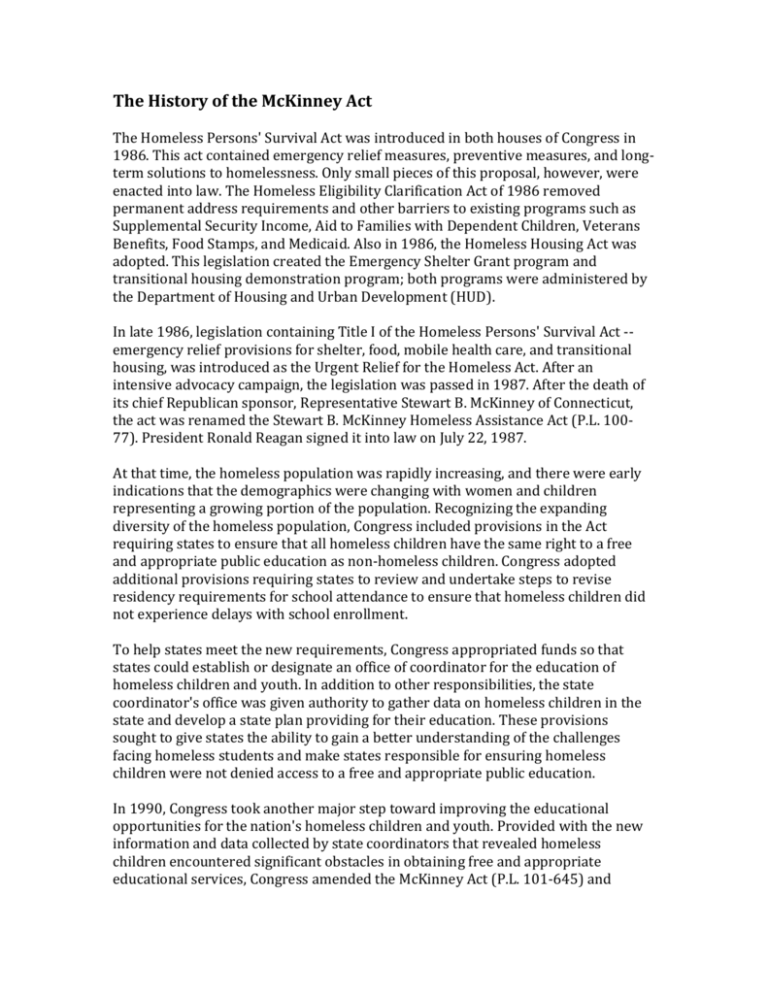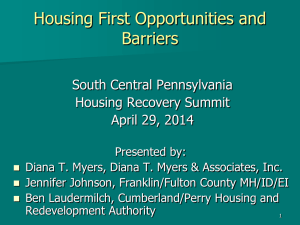The History of the McKinney Act - Anoka
advertisement

The History of the McKinney Act The Homeless Persons' Survival Act was introduced in both houses of Congress in 1986. This act contained emergency relief measures, preventive measures, and longterm solutions to homelessness. Only small pieces of this proposal, however, were enacted into law. The Homeless Eligibility Clarification Act of 1986 removed permanent address requirements and other barriers to existing programs such as Supplemental Security Income, Aid to Families with Dependent Children, Veterans Benefits, Food Stamps, and Medicaid. Also in 1986, the Homeless Housing Act was adopted. This legislation created the Emergency Shelter Grant program and transitional housing demonstration program; both programs were administered by the Department of Housing and Urban Development (HUD). In late 1986, legislation containing Title I of the Homeless Persons' Survival Act -emergency relief provisions for shelter, food, mobile health care, and transitional housing, was introduced as the Urgent Relief for the Homeless Act. After an intensive advocacy campaign, the legislation was passed in 1987. After the death of its chief Republican sponsor, Representative Stewart B. McKinney of Connecticut, the act was renamed the Stewart B. McKinney Homeless Assistance Act (P.L. 10077). President Ronald Reagan signed it into law on July 22, 1987. At that time, the homeless population was rapidly increasing, and there were early indications that the demographics were changing with women and children representing a growing portion of the population. Recognizing the expanding diversity of the homeless population, Congress included provisions in the Act requiring states to ensure that all homeless children have the same right to a free and appropriate public education as non-homeless children. Congress adopted additional provisions requiring states to review and undertake steps to revise residency requirements for school attendance to ensure that homeless children did not experience delays with school enrollment. To help states meet the new requirements, Congress appropriated funds so that states could establish or designate an office of coordinator for the education of homeless children and youth. In addition to other responsibilities, the state coordinator's office was given authority to gather data on homeless children in the state and develop a state plan providing for their education. These provisions sought to give states the ability to gain a better understanding of the challenges facing homeless students and make states responsible for ensuring homeless children were not denied access to a free and appropriate public education. In 1990, Congress took another major step toward improving the educational opportunities for the nation's homeless children and youth. Provided with the new information and data collected by state coordinators that revealed homeless children encountered significant obstacles in obtaining free and appropriate educational services, Congress amended the McKinney Act (P.L. 101-645) and expressed an intolerance of any barrier that prohibited the enrollment of homeless children and youth. Furthermore, Congress acknowledged that the true challenge was not simply to enroll homeless children, but to promote their academic success in public school. Specifically, the McKinney amendments required state homeless education coordinators to look beyond residency issues toward other issues that were keeping homeless children and youth out of school. Congressional policy expanded the state's responsibility to eliminate the barriers to the education of homeless children and youth. As a result, the states were required to review and revise ALL policies, practices, laws, and regulations that might act as a barrier to the enrollment, attendance, or academic success of homeless children and youth. States were additionally responsible for assuming a leadership role in ensuring that local education agencies review and revise policies and procedures that might similarly impede the access of homeless children and youth to a free and appropriate public education. With Congressional recognition of the need to promote the academic success of homeless students came the authorization provision of direct educational services. Prior to passage of the 1990 amendments, states were prohibited from using McKinney funds to provide direct educational services. Since 1990, however, states have been authorized, within certain limits to award grants to local education agencies (LEAs) for an array of educational and support services in response to the needs of homeless students. Today, schools that apply for, and receive, McKinney funds may use them to provide before school and after school programs, tutoring programs, referrals for medical and mental health services, pre-school programs, parent education, counseling, social work services, transportation services, and other services that may not otherwise have been provided by the public school program. In furtherance of this policy, Congress increased appropriations significantly from 1987 levels. Congress amended the McKinney Act again in 1994 as part of its reauthorization of the Improving America's Schools Act (P.L. 103-382). In this legislation, Congress demonstrated continued support for its previous policies and worked to increase legal protections of homeless children and youth to ensure that they had greater access to the appropriate education services provided under federal, state, and local law. Under the new amendments, states are authorized to extend the program services funded by McKinney to preschool children and on sectarian property, where it is constitutionally permissible to do so. Additionally, LEAs receiving McKinney funds were provided greater flexibility in developing programs to meet the educational, social, and health needs of homeless children and youth by removing categorical spending limits within the law. Congress also added protections requiring states to ensure that school districts abide by a parent's or guardian's request to enroll a homeless child in a particular school to the extent that such a request is feasible. Congress also strengthened provisions in the Act requiring interagency coordination and collaboration between state and local education agencies and other agencies and organizations that provide services to homeless people. In 2001, Congress again reauthorized the McKinney Education of Homeless Children and Youth Program as the McKinney-Vento Homeless Education Assistance Improvements Act in the No Child Left Behind Act (P. L. 107-110), signed by President George W. Bush on January 8, 2002. According to the National Coalition for the Homeless (2001), Congress was influenced by statistics that over one million children and youth were likely to experience homelessness in a given year and extreme poverty, coupled with high mobility and loss of housing, placed these children at great risk for educational challenges. These data resulted in additional supports being incorporated into the law. Among the changes for the Office of State Coordinator is the requirement to strengthen state support to all school divisions by coordinating with local liaisons to ensure accountability, greater flexibility to use McKinney-Vento funds, and increases in funding. The reauthorization strengthens the policy that homeless students should be integrated with their housed peers by explicitly prohibiting the segregation of homeless students through the creation of new separate schools or separate programs within schools and by requiring the Office of State Coordinator to provide technical assistance to promptly integrate homeless children and youth attending separate schools and programs into schools and programs serving non-homeless students. Clarification of who is considered homeless is addressed by describing specific situations that qualify students as homeless. The McKinney-Vento Homeless Assistance Act was reauthorized by Congress as Title X, Part C of the No Child Left Behind Act, H.R. 1 (Public Law 107-110) and became effective July 1, 2002. The purpose of the law is to close the achievement gap with accountability, flexibility, and choice so that no child is left behind.







